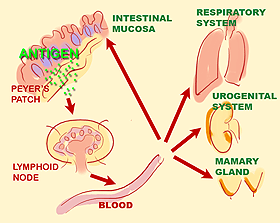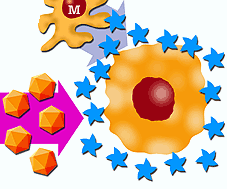|
POINTS TO NOTE REGARDING INFECTIONS |
|
INFECTION: |
| |
PRIMARY or SECONDARY
LOCAL or SYSTEMIC |
|
INFECTION PATHWAY: |
| |
SKIN
MUCOSAE |
|
INFECTIOUS CHARACTERISTICS OF THE AGENT: |
| |
INTRACELLULAR
EXTRACELLULAR
BOTH |
|
Throughout previous chapters we have reviewed the different immune (natural and adaptive response) and non-immune (physical-chemical barriers) mechanisms available to the porcine immune system, as well as the differences between the primary and secondary response. In this chapter we will cover the importance of the infection pathway when stimulating one or another immune mechanisms, as well as the role that the infection characteristics of the infectious agent itself can play in immune activation. Questions such as: Is the infection extracellular? Or just intracellular? Or both? are important when assessing which of the different immune mechanisms is most relevant.
|
|
| The most frequent infection pathways. |

Stimulation of the lymphoid tissue of the mucosae. BALT or GALT. This mechanism enables the immune response to be generalized even though antigenic stimulation has been local.
|
In the pig the foreign agents tend to penetrate more frequently through the respiratory and digestive mucosae and through the skin. To a lesser extent infections are also found in the urogenital tract.
The mucosae are protected by the natural and adaptive immunity mechanisms thanks to the mucosae-associated lymphoid tissue, consisting of nodular lymphoid tissue. Depending on their location, these are known as: GALT (gut-associated lymphoid tissues) and BALT (bronchial-associated lymphoid tissues). The immunity of these mucosae have some very important characteristics compared to systemic immunity, in both their structural elements (M cells, greater importance of the IgA) and functional elements, allowing local antigenic stimulation, inducing a local and general response. All the information and characteristics of the immune response of the mucosae can be found in chapter 3. |
|

Interferon is involved in the natural response, inducing transitory resistance in cells |
The other most common infection pathways in pigs is through the skin, either through small wounds, inoculation with a syringe or parasites. Normally, most of these infections do not develop, thanks to the activation of the natural response mechanisms (phagocytosis, NK activation, activation of the alternative pathway of the complement, interferon, etc). However, if the infection progresses, the antigen will be carried by the macrophages to the local lymph node, where it is processed by the antigen-presenting cells and presented to the CD 4+ lymphocytes, starting the production of antibodies and all humoral defence mechanisms already described. If the foreign agent is not extracellular, cytotoxic mechanisms mediated by ADCC and CD 8+ will be triggered. Cytotoxic T lymphocytes
© James A. Sullivan, Cells Alive!
(187 Kb.) In the first part of its tract, the urogenital route behaves in the same way as mucosae immunity. The predominant immunoglobulin in the cervicovaginal mucous of the sow is IgA. Nevertheless, the predominant immunoglobulin in the interior of the uterus is IgG. At genital level, in addition to natural immunity mechanisms, cell and humoral mechanisms of the adaptive response can be induced. |
|
| Infectious characteristics of the foreign agent. |
|
The infectious characteristics of the foreign agent also play an important role when selecting the most effective mechanisms. For example, if the infection cycle of the foreign agent is intracellular, the most effective mechanisms will be those that induce cytotoxicity, particularly cell cytotoxicity; either induced by the NK cells natural response, the activation of the complement by the classical pathway, or by adaptive immunity mechanisms, such as: activation of CD 8+ lymphocytes, macrophage activation, by CD 4 Th1lymphocytes, or even by the activation of the complement by the classical pathway or the activation of antibody-dependent cell-mediated cytotoxicity (ADCC) |
Whilst the infectious agent has an extracellular cycle of infection, the most important mechanisms will be humoral, mediated by the antibodies stimulated by Th 2 lymphocytes. The antibodies induce neutralization of the infectious agent, and its opsonization promotes phagocytosis by macrophages due to the Fc receptor.
Some infectious agents (for example many viruses) present both cycles during infection. Therefore, the extracellular viral particle appears, and the infected cells will also show infection antigens in their membrane which induce different cytotoxic mechanisms.
|
|
|

